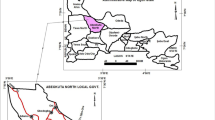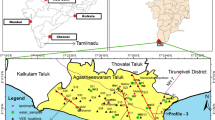Abstract
An integrated approach involving electrical resistivity, hydrogeologic, hydrogeochemical and remote sensing has been employed to investigate the occurrence, facies, quality and hydrogeologic systems of the aquifer units of groundwater in the low latitude crystalline basement complex terrain of Ogbomoso North, Southwestern Nigeria. Vertical electrical soundings (VES) were conducted at 56 locations across the study area using Schlumberger electrode configuration with a maximum current electrode separation of 240 m along northeast–southwest azimuth. The layering models obtained from the interpretation of VES data were used to construct the 2-D geoelectric section for the study area. The static water level, depth, geographic coordinates and elevations of 130 hand-dug wells within the study area were also measured to construct the groundwater flow map. Hydrogeochemical studies involved in situ measurements of such parameters as electrical conductivity (EC), acidity (pH) and total dissolved solid (TDS) using calibrated WTW Conductivity/TDS meter (LF 90) sand HACH pH Sension meter, respectively, and laboratory analysis of 25 representative water samples for anion and cation concentration. Prominent lineaments were also mapped from side-looking airborne radar imagery of the area and used to obtain the lineaments orientations and joints systems vide Rose diagram. Interpretation of the VES data revealed a three- to four-layer earth model with the three-layer resistive–conductive–resistive geoelectrical signature as the most dominant constituting 62 % of the entire apparent resistivity curves. The fractured/weathered basement constitutes the aquifer units (confined/unconfined) while the conductive zones comprise clay/sandy clay/clayey sand. The 2-D geoelectric section revealed lenses of sand and clay, sand atoll and fresh/fracture basement at different depths. The lineament length varied from 0.72 to 1.39 km and 0.11 to 0.56 km for long and short lineaments, respectively. The long lineaments trend in the east–west direction and indicated shallow weathering while the short lineaments trend NW–SE and NE–SW directions indicating deep weathering in such directions. Two joint systems trending NW–SE and NE–SW as well as joints in the E–W direction were also revealed. The direction of groundwater flow was southward and westward with the recharge areas along topographic high trending NE–SW. The EC, pH and TDS ranged between 0.10 and 1.58 mS/cm, 5.0 and 7.3 and 60 and 920 mg/l, respectively, with corresponding mean of 0.60 ± 0.06 mS/cm, 6.8 ± 0.10, and 342 ± 34 mg/l. The anionic dominance was of the order CO3 2− > Cl− > NO3 − > SO4 2− > PO4 3− > Fl− and the concentrations of the cations were of the order Ca2+ > Na+ > K+. Furthermore, all the elemental concentrations were within the World Health Organization standard limit for drinking water save for high nitrate concentration in samples collected from very few locations. Twelve groundwater facies were identified each representing different rock types and products of weathering. The groundwater is localized within the fractured/weathered basement with moderately thick overburden and capable of sustaining industrial development, increasing urbanization as well as providing access to clean water. The corroboration between the joint system and the direction of groundwater flow indicated the groundwater flow is structural controlled.

































Similar content being viewed by others
References
Acworth RI (1987) The development of crystalline basement aquifers in a tropical environment. Q J Eng Geol 20:265–272
Adabanija MA, Omidiora EO, Olayinka AI (2008) Fuzzy logic modeling of the resistivity sounding measurement and topography features for aquifer assessment in hydrogeological investigation of basement complex. Hydrogeol J 16:461–481
Adegoke TO (2010) Application of electrical resistivity method to foundation investigation of some parts of LAUTECH, South-Western Nigeria. B. Tech thesis, Ladoke Akintola University of Technology, Ogbomoso, Nigeria
Afolabi OA, Kolawole LL, Abimbola AF, Olatunji AS, Ajibade OM (2013) Preliminary study of the geology and structural trends of lower Proterozoic Basement rocks in Ogbomoso, SW Nigeria. J Environ Earth Sci 3(8):82–95
Ajayi O, Adegoke-Anthony CW (1988) Groundwater prospects in the basement complex rocks of southwestern Nigeria. J Afr Earth Sci 7(1):227–234
Amiotte SP, Probst J, Ludwig W (2003) Worldwide distribution of continental rock lithology: implications for the atmospheric/soil CO2 uptake by continental weathering and alkalinity river transport to the oceans. Glob Biogeochem Cycles 17:1038
Asseez LO (1972) Hydrogeology of Southwestern Nigeria. Niger Eng 7(1):22–44
Back W (1961) Techniques for mapping of hydrochemical facies. U.S. Geological Survey Professional Paper 424-D, pp 380–382
Banks D, Robins N (2002) An introduction to groundwater in crystalline bedrock. Norges geologiske undersokelse, p 64. ISBN 8273861001
Bianchi L, Snow DT (1969) Permeability of crystalline rocks from measured orientations and apertures of fractures. Ann Arid zones 8(2):231–245
Cahen L, Snelling NJ, Delhal J, Vail JR (1984) The geochronology and evolution of Africa. Clarendon press, Oxford, p 512
Comte J-C, Cassidy R, Nitsche J, Ofeterdinger U, Pilatova K, Flynn R (2012) The typology of Irish-hard-rock aquifers based on an integrated hydrogeological and geophysical approach. Hydrogeol J 20:1569–1588
Crain ER (2007) Crain’s petrophysical handbook. http://www.spec2000.net/00-refmanuals.htm
D’Strata Drilling Services (2007) Technical report on groundwater prospecting and water boreholes drilled in some parts of Ogbomoso, Southwestern Nigeria. In: Oyo State Project Support Unit, World Bank Assisted Local Empowerment and Environmental Management Programme Water Project
Davis SN, DeWiest RJM (1966) Hydrogeology. Wiley, USA, p 463
Durand V, Deffontaines B, Leonardi V et al (2006) A multidisciplinary approach to determine the structural geometry of hard-rock aquifers: application to the Plancoet migmatitic aquifer (NE Brittany, W. France). Bull Soc Geol Fr 177:227–236
Edet AE, Okereke CS (1997) Assessment of hydrogeological conditions in basement aquifers of the Precambrian Oban Massif, southeastern Nigeria. J Appl Geophys 36:195–204
Eduvie MO, Olabode OT (2001) Evaluation of aquifer potential in the crystalline basement using geoelectric sounding data from the southern part of Kaduna State, Nigeria. Water Resour J 12(2):56–61
Esu OE (1993) Fracture mapping-scientific basis for well sitting in hard rocks. Water Resour J 4(1 & 2):25–35
Faybishenko B, Benson SM (2000) Preface ix. In: Faybishenko B, Witherspoon PA, Benson SM (eds) Dynamics of fluid in fractured rock, Geophysical Monographs, 122nd edn. American Geophysical Union, Washington, DC
Gutasfon G, Krasny J (1994) Crystalline aquifers: their occurrence, use and importance. Hydrogeol J 2:64–75
Krasny J (2002) Quantitative hardrock hydrogeology in a regional scale. Norgesgeol uUdersokelse Bull 439:7–14
Loke MH, Barker RD (1996) Rapid least-squares inversion of apparent resistivity pseudosections using quasi-Newton method. Geophys Prospect 44:131–152
McCurry P, Wright JB (1977) Geochemistry of Calc-alkaline volcanic in northwestern Nigeria, and a possible Pan-African suture zone. Earth Planet Sci Lett 37:90–96
Odusanya BO (1989) An empirical resistivity model for predicting shallow groundwater occurrence in the Basement Complex. M.Sc. Thesis, University of Ibadan, Nigeria
Olayinka AI, Akpan EJ, Magbagbeola OA (1997) Geoelectric sounding for estimating aquifer potential in the crystalline basement area around Saki, southwestern Nigeria. Water Resour J 8(1 & 2):71–81
Olorunfemi MO, Fasuyi SA (1993) Aquifer types and the geoelectrical/hydrogeologic characteristics of part of the central basement terrain of Nigeria. J Afr Earth Sci 16:309–317
Oluyide PO, Udey AN (1965) Preliminary comments on the fracture system of Nigeria. In: Paper presented at the National seminar on Earthquakes in Nigeria. Ahmadu Bello University, Zaria, Nigeria
Rahaman MA (1988) Recent advances in the study of the basement complex of Nigeria. In: Oluyide PO (Co-ordinator) Precambrian Geology of Nigeria. Geological Survey, Nigeria Publication, pp 11–43
Sadashivaiah C, Ramakrishnaiah CR, Ranganna G (2008) Hydrochemical analysis and evaluation of groundwater quality in Tumkur Taluk, Karnataka State, India. Int J Environ Res Public Health 5(3):158–164
Shroeder HA (1960) Relations between hardness of water and death rates from certain chronic and degenerative diseases in the United States. J Chronic Dis 12:586–591
Turner DC (1983) Upper Proterozoic Schist Belts in the Nigerian sector of the Pan African Province of West Africa. Precambrian Res 21:55–79
WHO (2004) Water sanitation and health programme, managing water in the home; accelerated health gains from improved water sources. World Health Organization. http://www.who.int
Zekster IS, Everett LG (2004) Groundwater resources of the world and their use, IHPVI, Series on Groundwater No. 6. UNESCO (United Nations Educational, Scientific and Cultural Organisation)
Acknowledgments
The authors are grateful to the Federal Ministry of Forestry and D’Strata Drilling Services, Ibadan, Nigeria, for providing the SLAR imagery map and boreholes’ information, respectively.
Author information
Authors and Affiliations
Corresponding author
Rights and permissions
About this article
Cite this article
Adabanija, M.A., Afolabi, A.O., Olatunbosun, A.T. et al. Integrated approach to investigation of occurrence and quality of groundwater in Ogbomoso North, Southwestern Nigeria. Environ Earth Sci 73, 139–162 (2015). https://doi.org/10.1007/s12665-014-3401-8
Received:
Accepted:
Published:
Issue Date:
DOI: https://doi.org/10.1007/s12665-014-3401-8




